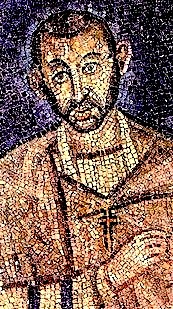Ambrose
Bishop of Milan who became one of the most influential ecclesiastical figures of the 4th century
Biography
Aurelius Ambrosius, better known in English as Saint Ambrose (c. between 337 and 340 – 4 April 397), was a bishop of Milan who became one of the most influential ecclesiastical figures of the 4th century. He was one of the four original doctors of the Church.
Ambrose was born into a Roman Christian family between about 337 and 340 and was raised in Trier. His father was Aurelius Ambrosius, the praetorian prefect of Gaul; his mother was a woman of intellect and piety. Ambrose's siblings, Satyrus (who is the subject of Ambrose's De excessu fratris Satyri) and Marcellina, are also venerated as saints. There is a legend that as an infant, a swarm of bees settled on his face while he lay in his cradle, leaving behind a drop of honey. His father considered this a sign of his future eloquence and honeyed tongue. For this reason, bees and beehives often appear in the saint's symbology.
After the early death of his father, Ambrose followed his father's career. He was educated in Rome, studying literature, law, and rhetoric. Praetor Anicius Probus first gave him a place in the council and then in about 372 made him consular prefect or "Governor" of Liguria and Emilia, with headquarters at Milan, which was then (beside Rome) the second capital in Italy.
Ambrose was the Governor of Aemilia-Liguria in northern Italy until 374 when he became the Bishop of Milan. He was a very popular political figure, and since he was the Governor in the effective capital in the Roman West, he was a recognizable figure in the court of the Emperor Valentinian I. Ambrose never married.
In the late 4th century there was a deep conflict in the diocese of Milan between the Catholics and Arians. In 374 the bishop of Milan, Auxentius, an Arian, died, and the Arians challenged the succession. Ambrose went to the church where the election was to take place, to prevent an uproar, which was probable in this crisis. His address was interrupted by a call "Ambrose, bishop!", which was taken up by the whole assembly.
was known to be Catholic in belief, but also acceptable to Arians due to the charity shown in theological matters in this regard. At first he energetically refused the office, for which he was in no way prepared: Ambrose was neither baptized nor formally trained in theology.[1] Upon his appointment, St. Ambrose fled to a colleague's home seeking to hide. Upon receiving a letter from the Emperor Gratian praising the appropriateness of Rome appointing individuals evidently worthy of holy positions, St. Ambrose's host gave Ambrose up. Within a week, Ambrose was baptized, ordained and duly consecrated bishop of Milan.
As bishop, he immediately adopted an ascetic lifestyle, apportioned his money to the poor, donating all of his land, making only provision for his sister Marcellina (who later became a nun), and committed the care of his family to his brother. Ambrose also wrote a treatise by the name of "The Goodness Of Death".
Under Ambrose's major influence, emperors Gratian, Valentinian II and Theodosius I carried on a persecution of Paganism. Under Ambrose's zealous pressure, Theodosius issued the infamous 391 "Theodosian decrees," a declaration of war on paganism, and the Altar of Victory was removed by Gratian. Ambrose prevailed upon Gratian, Valentinian and Theodosius to reject requests to restore the Altar.
Soon after acquiring the undisputed possession of the Roman empire, Theodosius died at Milan in 395, and two years later (April 4, 397) Ambrose also died. He was succeeded as bishop of Milan by Simplician. Ambrose's body may still be viewed in the church of S. Ambrogio in Milan, where it has been continuously venerated — along with the bodies identified in his time as being those of Sts. Gervase and Protase — and is one of the oldest extant bodies of historical personages known outside Egypt.
--Excerpts from Wikipedia